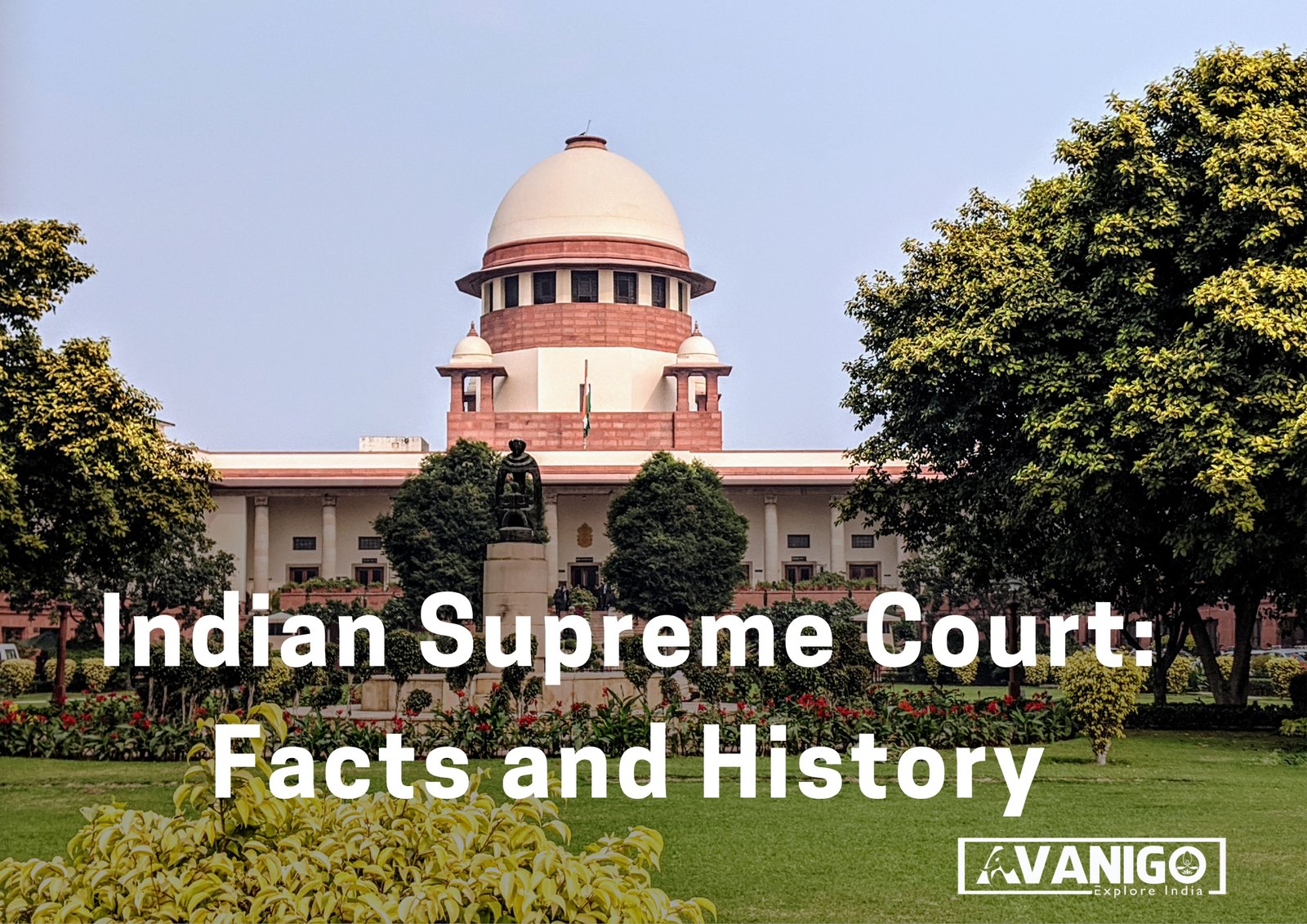The Indian Supreme Court is the highest and most important law authority in India, and it is where serious legal matters are decided. Located in our capital, Delhi, it is like the head teacher of all courts. Though other courts also solve legal problems, the Supreme Court provides the final answer to the biggest legal questions in our country. Once Supreme Court makes a decision, no other court can say it is wrong. In this article, we will learn some exciting facts about the Indian Supreme Court in a simple way that you can understand easily.
Quick Navigation
History of Supreme Court India
India’s Supreme Court came into its power on January 26, 1950 – our Republic Day. Before that, there was no Supreme Court, and the Federal Court held the highest position under British rule in India.
Legendary leaders like Mahatma Gandhi, Nehru Ji, and Dr Ambedkar decided that after freedom, India must have its very own apex Court that will be at the top of everything. That’s why they wrote our revered Constitution and structured the Supreme Court in it.
The first chief of Supreme Court India was Justice Harilal Jekisundas Kania. He, along with six other renowned honorable judges, began the work of the Court on January 28, 1950. In the early stages of Supreme Court formation, this team used to work from a small room in Delhi. Later, a historic, landmark, magnificent building was constructed for the Supreme Court, which is the current building.
In summary, our Supreme Court began guiding India on January 28, 1950, as the apex court under the light of Justice Kania.
Present Supreme Court Building and Architecture
Early on, as mentioned, the Indian Supreme Court used to work from a small room. But now it has a vast and magnificent building located in New Delhi. The building has three wings – Centre, Left and Right-wing. The Centre wing houses the Chief Justice’s Court, which is the largest courtroom. The two side wings have other court halls.
The most exciting thing is the architecture and structure of the Supreme Court. It is designed like a scale of justice, which is a famous symbol of justice. The scales have two plates balanced by a beam.
Similarly, the Supreme Court building has the Centre wing as the balancing beam and the two side wings as the balancing plates. In between the centre and side wings is a beautiful garden with a sculpture. The sculpture shows a mother holding her child and depicts justice being done to all sections of the society in India. Read facts about Indian Parliament.
Seal of the Supreme Court
The seal of the Supreme Court is an integral part of our past related to justice. It has a 24-spoke wheel taken from the Dharmachakra on top of the well-known Lion Pillar in the garden of Sarnath, from emperor Ashoka’s time. Below this wheel are written the words “Yato Dharma Stato Jaya” in Sanskrit. They mean, “Where there is Dharma (Righteousness), there is Victory”. This shows the Supreme Court believes in upholding truth and fairness in India.

Jurisdiction and Powers
Our Supreme Court has many super special abilities and gigantic tasks to carry out as the mightiest institution of justice.
- Original Jurisdiction: Under a special Article, if any argument happens directly between the governments of India and the states, the Supreme Court teachers can listen to it as the first receivers. They use their original wisdom to solve disputes between big brothers.
- Appellate Jurisdiction: Most days, appeals or challenges against the rules of the High Court land on their table under guiding Articles. If any brother or sister is unhappy with the High Court decision, they can cast an appeal spell in the Supreme Court to change it.
- Advisory Jurisdiction: At times, the leader of India, the President, seeks enlightenment from Supreme Court gurus on critical legal puzzles by using a secretly powerful Article. The judges then work their advisory magic to help clear doubts.
- Writ Jurisdiction: Through an Article, the Supreme Court wields mighty writs like Habeas Corpus and Mandamus that can force any brother or sister to produce another person or do their task. They use this wonder to protect our Rights.
- Power of Judicial Review: The weightiest duty is one that no other court has – if any law by Parliament goes against the Indian Constitution, Supreme Court comrades can wave their hands and declare it a zero.
Composition of Supreme Court of India
At the time of writing this article (2024), the Supreme Court can have a maximum of 34 judges, including the Chief Justice. The President selects the judges with help from a special crew called Collegium.
Any person with the following qualities can become a Supreme Court judge:
- Should be a lawyer for at least ten years in one or multiple High Courts.
- Serve as High Court Judge for at least five years.
- Age lower than 65 years.
Through the decades, many patriots like Justice Khanna, Justice Bhagwati, Justice Pathak and Justice Iyer became Supreme Court judges and even Chief Justices.
Landmark Judgments of Supreme Court India
In the past seven decades, the Supreme Court has faced thousands of difficult quests and brought joy through landmark rulings. Here are some that strengthened India:
- Kesavananda Bharati Case (1973): MPs fought fiercely to decide if the Constitution could be altered at will. Through their bold skills, the Supreme Court of India declared that basic rights can never change.
- Vishaka Case (1997): The Supreme Court ordered ways to thwart abuse and harassment of sisters in offices until a new law comes.
- National Judicial Appointments Case (1998, 2015, 2016): The Supreme Court safeguarded the autonomy of the judiciary and left the final authority on appointing new judges to the judiciary through such crucial judicial pronouncements as the Third Judges case as well as the Second Judges case.
- Right to Privacy Case (2017): Privacy was recognized as a Fundamental Right under Article 21 for the first time.
- Sabarimala Temple Case (2018): It was held that discrimination on biological and physiological features of women violated their Right to Worship.
- Ayodhya Rama Mandir Case: an extensive legal dispute over land ownership ensued between the Muslim and Hindu communities. Only in 2019, following decades of legal proceedings, did the Supreme Court finally decide to provide the land for the construction of Ram Mandir in Ayodhya.
In this way, through thousands of judgments, the Supreme Court has defended Indian democracy and promoted the rule of law, justice and the rights of citizens.
Visiting the Supreme Court
People cannot simply walk into the Indian Supreme Court building and courts like other places. But students and ordinary people can visit it on weekends and holidays to see and learn about our judicial system. Here is a brief guide how to visit Supreme Court India:
- Go to the Supreme Court reception and take passes after showing proof of ID.
- You will be guided on a tour of the building and can see the model.
- You can see court proceedings from the spectator’s gallery on working days from 10:30 AM to 1 PM.
- Also, see amazing bronze gates, a library and beautiful fountains in the garden area.
- Must maintain decorum and follow instructions of guides and security staff.
- No phones, bags or books are allowed inside courtrooms.
Visiting Supreme Court is a life-changing experience for any citizen, especially school students, to study facts about the Indian Supreme Court and understand its glorious role in our lives.
Conclusion
We have learnt facts about the Indian Supreme Court easily. The Supreme Court protects the values of justice, equality and fundamental rights for all Indians that we read about in our sacred Constitution. Though they have many severe cases, the Supreme Court remains the ray of hope for right and truth.
Swetha is a Content Specialist, LinkedIn Branding and B2B Marketing Consultant. When she is not in the world of B2B, she researches the roots and beauty of Indian Culture and Traditions. She is the author of the book: 365 Days 365 Posts – The Guide to LinkedIn Personal Branding, available exclusively on Amazon. Connect with her on LinkedIn.

